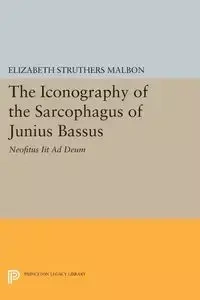The Iconography of the Sarcophagus of Junius Bassus - Elizabeth Malbon Struthers
- Neofitus Iit Ad Deum
Carved for a Roman city prefect who was a newly baptized Christian at his death, the sarcophagus of Junius Bassus is not only a magnificent example of "the fine style" of mid-fourth-century sculpture but also a treasury of early Christian iconography clearly indicating the Christianization of Rome--and the Romanization of Christianity. Whereas most previous scholarship has focused on the style of the sarcophagus, Elizabeth Struthers Malbon explores the perplexing elements of its iconography in their fourth-century context. In so doing she reveals the distinction between "pagan" and Christian images to be less rigid than sometimes thought.
Against the background of earlier and contemporary art and religious literature, Malbon explicates the relationship of the facade's two levels of scenes depicting stories from the Old and New Testaments, the connection between the scenes on the facade with those on the lid and ends of the sarcophagus, and the integration of pagan elements within a Christian work. What emerges is a carefully constructed iconographic program shedding light on the development of early Christian art within late antique culture.
Originally published in 1990.
The Princeton Legacy Library uses the latest print-on-demand technology to again make available previously out-of-print books from the distinguished backlist of Princeton University Press. These editions preserve the original texts of these important books while presenting them in durable paperback and hardcover editions. The goal of the Princeton Legacy Library is to vastly increase access to the rich scholarly heritage found in the thousands of books published by Princeton University Press since its founding in 1905.
EAN: 9780691604862



Carved for a Roman city prefect who was a newly baptized Christian at his death, the sarcophagus of Junius Bassus is not only a magnificent example of "the fine style" of mid-fourth-century sculpture but also a treasury of early Christian iconography clearly indicating the Christianization of Rome--and the Romanization of Christianity. Whereas most previous scholarship has focused on the style of the sarcophagus, Elizabeth Struthers Malbon explores the perplexing elements of its iconography in their fourth-century context. In so doing she reveals the distinction between "pagan" and Christian images to be less rigid than sometimes thought.
Against the background of earlier and contemporary art and religious literature, Malbon explicates the relationship of the facade's two levels of scenes depicting stories from the Old and New Testaments, the connection between the scenes on the facade with those on the lid and ends of the sarcophagus, and the integration of pagan elements within a Christian work. What emerges is a carefully constructed iconographic program shedding light on the development of early Christian art within late antique culture.
Originally published in 1990.
The Princeton Legacy Library uses the latest print-on-demand technology to again make available previously out-of-print books from the distinguished backlist of Princeton University Press. These editions preserve the original texts of these important books while presenting them in durable paperback and hardcover editions. The goal of the Princeton Legacy Library is to vastly increase access to the rich scholarly heritage found in the thousands of books published by Princeton University Press since its founding in 1905.
EAN: 9780691604862

